Breast: Proliferative Lesions
Proliferative Lesions
Lesions without Atypia
- Fibroadenoma
- Intraductal Papilloma
- Usual Ductal Hyperplasia
- Benign Sclerosing Lesions:
- Radial Scar (RS): < 1 cm
- Complex Sclerosing Lesion (CSL): > 1 cm
- Sclerosing Adenosis – Lobular Lesion with Increased Fibrous Tissue & Interspersed Glandular Tissue
Lesions with Atypia
- Atypical Ductal Hyperplasia (ADH)
- Atypical Lobular Hyperplasia (ALH)
Risk for Upgrade to Malignancy After Excision
- Low:
- Fibroadenoma
- Usual Ductal Hyperplasia
- Sclerosing Adenosis
- Intraductal Papilloma: 5-15%
- Benign Sclerosing Lesions (RS/CSL): 8-20%
- Atypical Ductal Hyperplasia (ADH): 5-10%
- Atypical Lobular Hyperplasia (ALH): 2.5%
Diagnosis
- Initial Evaluation: Imaging (Mammogram/US)
- Diagnosis: Core Needle Biopsy (CNB)
- Specifics for Benign Sclerosing Lesions:
- Imaging May Demonstrate Stellate Lesions with Central Translucency/Sclerosis & Entrapped Peripheral Ducts/Lobules
- Pathology: Fibroelastic Core with Distorted/Stellate Ducts
- *See Breast: Breast Mass Evaluation
Treatment
- Most Lesions without Atypia Require No Further Intervention
- Indications for Surgical Excision:
- Atypia (ADH/ALH)
- May Consider Avoiding Excision for ALH if Imaging & Biopsy are Concordant
- Benign Sclerosing Lesions (Radial Scar/Complex Sclerosing Lesion)
- Intraductal Papilloma
- Atypia (ADH/ALH)
- Margins: No Margin Required
- Goal: All Suspicious/Calcified Areas on Mammogram
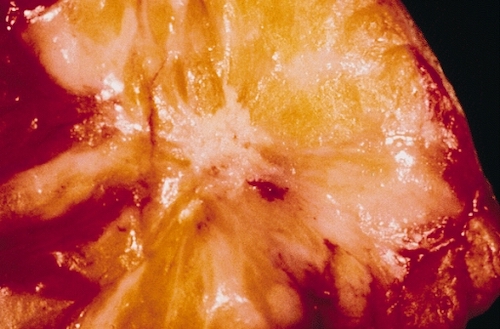
Radial Scar; Gross Pathology 1
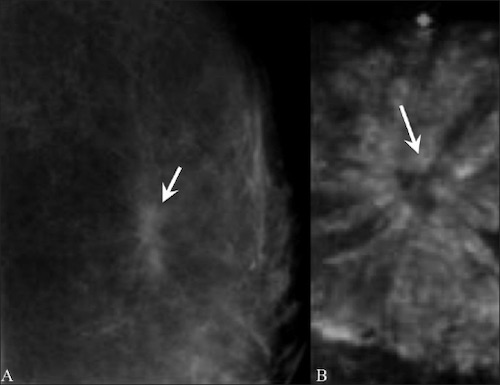
Radial Scar; (A) Mammogram, (B) 3D Multiplanar US 2
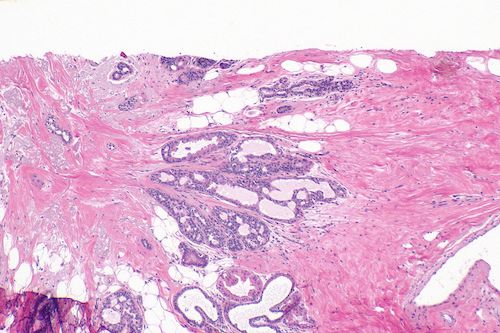
Radial Scar; Histology 3
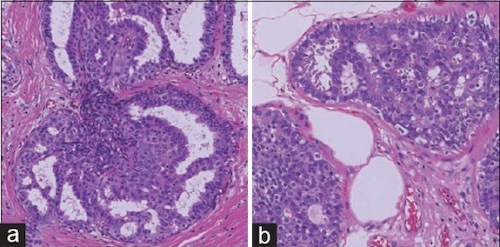
Intraductal Lesions: (A) Usual Ductal Hyperplasia, (B) Atypical Ductal Hyperplasia 4
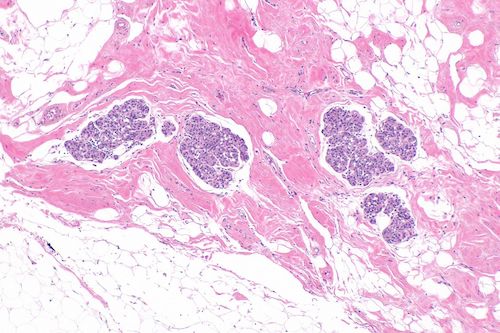
Atypical Lobular Hyperplasia 3
References
- The Armed Forces Institute of Pathology. Wikimedia Commons. (License: Public Domain)
- Shah G, Jankharia B. Pictorial essay: Breast USG. Indian J Radiol Imaging. 2010 May;20(2):98-104. (License: CC BY-2.0)
- Nephron. Wikimedia Commons. (License: CC BY-SA-4.0)
- Yamada M, Saito A, Yamamoto Y, Cosatto E, Kurata A, Nagao T, Tateishi A, Kuroda M. Quantitative nucleic features are effective for discrimination of intraductal proliferative lesions of the breast. J Pathol Inform. 2016 Jan 29;7:1. (License: CC BY-NC-SA-3.0)